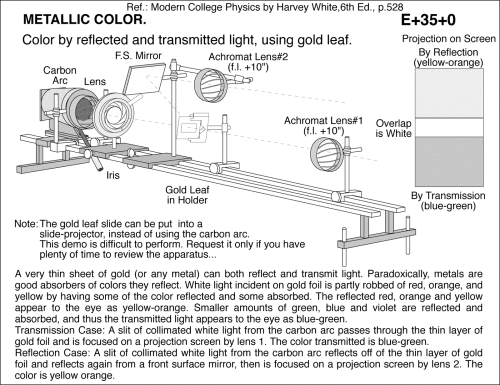Color by reflected and transmitted light, using gold leaf.
Primary tabs
A very thin sheet of gold (or any metal) can both reflect and transmit light. Paradoxically, metals are good absorbers of colors they reflect. White light incident on gold foil is partly robbed of red, orange, and yellow by having some of the color reflected and some absorbed. The reflected red, orange and yellow appear to the eye as yellow-orange. Smaller amounts of green, blue and violet are reflected and absorbed, and thus the transmitted light appears to the eye as blue-green. Transmission Case: A slit of collimated white light from the carbon arc passes through the thin layer of gold foil and is focused on a projection screen by lens 1. The color transmitted is blue-green. Reflection Case: A slit of collimated white light from the carbon arc reflects off of the thin layer of gold foil and reflects again from a front surface mirror, then is focused on a projection screen by lens 2. The color is yellow orange. Color by reflected and transmitted light, using gold leaf. Ref.: Modern College Physics by Harvey White,6th Ed., p.528 The gold leaf slide can be put into a slide-projector, instead of using the carbon arc. This demo is difficult to perform. Request it only if you have plenty of time to review the apparatus...
UCB Index:
E+35+0
PIRA Index:
6F10.61
UCB Taxonomy:
PIRA Taxonomy:
Popularity:
- Log in to post comments

